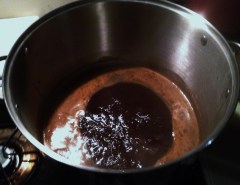Brewing your own beer is not as daunting as one may think.? Sure, there may be confusion and frustration during the initial steps as well as some impatience during waiting periods.? Still, when you are fortunate enough to make a good batch of beer, the end result, as well as the whole process to get there, can be quite rewarding.
The first step, of course, is to obtain the right equipment and basic ingredients for brewing.? Fortunately, Philadelphia has a couple of great spots specialing in home brewing:?Home Sweet Homebrew in Center City and Barry?s Homebrew Outlet?in Olde Kensington.? Home Sweet Homebrew?s owner, George Hummel, is extremely helpful in ensuring you?purchase the right equipment, suggesting ingredients based on your personal taste preferences.??There are?beginner?s beer kits, which contain all the ingredients you need?for a set recipe, or you can?buy individual ingredients for your?own personalized mix.
I bought the?deluxe kit, which comes with a?fermenter, a secondary glass carboy fermenter, bottle capper?and other necessary instruments?and runs about $89.95.? Additional items to purchase included a sanitizer (perhaps the most important item!), empty bottles, a?large stainless steel?pot?and a long-handled plastic spoon.
My first attempt at brewing was?an amber ale.??As a?beginner, I wanted t o?keep it basic and?bought the?kit with the ingredients and recipe.??When you start brewing, you quickly find out that you pretty much have to sanitize everything (the fermenter, the instruments, the beer bottles, etc.) before each use.??The big steps on brewing day include boiling the wort and mixing the ingredients before immediately cooling the pot and then placing them in the fermenter.? These first steps of the process take a?few hours.? I made the mistake of not budgeting enough time and starting the process at around 10 p.m. on the first night.? It didn?t finish until after 1 a.m.
o?keep it basic and?bought the?kit with the ingredients and recipe.??When you start brewing, you quickly find out that you pretty much have to sanitize everything (the fermenter, the instruments, the beer bottles, etc.) before each use.??The big steps on brewing day include boiling the wort and mixing the ingredients before immediately cooling the pot and then placing them in the fermenter.? These first steps of the process take a?few hours.? I made the mistake of not budgeting enough time and starting the process at around 10 p.m. on the first night.? It didn?t finish until after 1 a.m.
A couple of days later, I started becoming familiar with perhaps the second most important part of?brewing: siphoning.? The beer has to be transferred from the primary fermenter to the secondary glass carboy, and the way to do it is through siphoning.? It also helps to have someone assist in the siphoning process to hold the?hose as it fills up the carboy or ensure that the siphon flow doesn?t?get stuck.
 About a week later, it was time for bottling, which is when the fun?really starts and you feel the process has been successful.? Of course, everything involved in bottling (such as the bottle capper, caps,?hoses and bottles) has to be sanitized.? Priming sugar is boiled with water and then added to the fermenter.? The beer is siphoned back into the primary/bottling fermenter.??I attached?a bottle filling wand and?hose to the fermenter nozzle, and it was time to fill the bottles and cap them.? The?brewing made about 40 or so bottles.
About a week later, it was time for bottling, which is when the fun?really starts and you feel the process has been successful.? Of course, everything involved in bottling (such as the bottle capper, caps,?hoses and bottles) has to be sanitized.? Priming sugar is boiled with water and then added to the fermenter.? The beer is siphoned back into the primary/bottling fermenter.??I attached?a bottle filling wand and?hose to the fermenter nozzle, and it was time to fill the bottles and cap them.? The?brewing made about 40 or so bottles.

 You?re supposed to wait about another one to three?weeks before you start drinking the finished product.??I figured?eight days was good.? And the result?? It was?a pleasant amber ale taste, with distinctive hoppiness.??Relieved at the apparent success, I was eager to share?it with friends, many of whom commented that they enjoyed it.? No one has?told me to?my face that they hated or didn?t like it.? Except for my dad, who?is too used to Budweiser and Corona and thought it was too hoppy for him.??The best part about home brewing is not just the end result; rather, it?s about sharing?your good product with others.
You?re supposed to wait about another one to three?weeks before you start drinking the finished product.??I figured?eight days was good.? And the result?? It was?a pleasant amber ale taste, with distinctive hoppiness.??Relieved at the apparent success, I was eager to share?it with friends, many of whom commented that they enjoyed it.? No one has?told me to?my face that they hated or didn?t like it.? Except for my dad, who?is too used to Budweiser and Corona and thought it was too hoppy for him.??The best part about home brewing is not just the end result; rather, it?s about sharing?your good product with others.
Like this:
Be the first to like this.
Source: http://eatdrinkandrunphilly.com/2012/12/24/getting-started-in-home-brewin/
alex smith robert deniro mexico news the talented mr ripley weather new orleans orcl the hartford
No comments:
Post a Comment
Note: Only a member of this blog may post a comment.